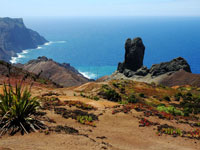Visit worldtravels.com for the full guide to St Helena. Build a complete St Helena travel guide and email to your clients - sign up for a trial subscription of World Travels Pro.
St Helena

A volcanic island rising out of the South Atlantic Ocean, the British territory of Saint Helena is one of the most isolated islands in the world, located 1,200 miles (nearly 2,000km) from the west coast of Africa with Ascension Island its nearest landmass, 703 miles (1,131km) away. Ascension Island is one of its dependencies along with Tristan da Cunha.
Despite its small size and remote location, St Helena has been described as a 'beautiful emerald set in bronze', with its lush subtropical forests and rolling hills almost entirely enclosed by sheer volcanic cliffs. Instead of bright lights, sandy beaches and shopping, the island offers tranquil beauty, and 19th century values imbued with 300 years of colonial history. Chief attractions include the island's Napoleonic history, the endemic Wirebird and various plants, Jonathan the ancient Giant Tortoise, and the Tungi distillery.
The Saints, as the islanders are called, are friendly and charming, a mixture of descendants from British settlers, African slaves and contracted workers from the East.
St Helena was discovered by the Portuguese in 1502, and lying directly in line with the trade winds that took ships rounding the southern tip of Africa into the South Atlantic, it soon became a preferred stopover for its supplies of fresh water and fruit trees, and a rendezvous point for homebound voyages from Asia. It became a British dependency in 1834 and for many years was used as a place of exile, most famously for Napoleon after his defeat at the Battle of Waterloo, as well as for Chief Dinizulu and thousands of Boer prisoners from the Anglo-Boer war in South Africa. Tourism promotes the life of Napoleon on the island where he lived in Longwood House for six years until his death in 1821, and the residence is now a museum owned by the French government.
St Helena's capital and only town is the Georgian seaport of Jamestown, nestled between towering cliffs and protected from the sea by 18th-century fortifications. The town's most prominent feature is Jacob's Ladder, 699 steps embedded into the near vertical cliffs that connects the valley floor to the top of Ladder Hill. It is popular with tourists, as well as runners who come from around the world to compete in the timed run every year. Other attractions in St Helena include the Heart-Shaped Waterfall, the castle and its gardens, Sandy Bay, and the Central Peaks. St Helena has no airport, though plans are in place to construct one, and can currently only be reached by ship.
Climate
St Helena has a pleasant year round climate with very little variation in temperature. Summers are warm and sunny, and winters are mild with rain. Temperatures do vary between Jamestown on the north shore and the higher central areas with inland temperatures averaging about 41-43°F (5-6°C) cooler and a higher rainfall.
Money
The official currency is the Saint Helena Pound (SHP), which is divided into 100 pence. It is on a par with the Pound Sterling, but has its own banknotes and coins, which are not accepted in UK banks. Pounds Sterling are however accepted on the island. There are no international banks on the island, but some places accept credit cards. The Bank of St Helena changes travellers cheques and major currencies. The bank is closed on Sundays.
Passport Visa
All foreigners should have at least six months validity remaining on their passports. No visas are required to visit St Helena. A return ticket, travel insurance and pre-booked accommodation are required. Proof of medical insurance is also a requirement if intending to stay longer than 48 hours. It is highly recommended for all travellers that passports have at least six months validity remaining after your intended date of departure from your travel destination. Immigration officials often apply different rules to those stated by travel agents and official sources. There is an entry fee charge of £12 for up to four days, £14 up to ten days, £16 up to 21 days, £20 up to 60 days, and £25 up to 90 days. If you wish to stay for longer than 90 days you should apply to the St Helena Immigration Control Board for a Residents Permit.
Entry Requirements
- US nationals require a valid passport. A visitor's pass is valid for three months.
- UK nationals require a valid passport for entry to St Helena.
- Canadians require a valid passport. A visitor's pass is valid for three months.
- Australians require a valid passport. A visitor's pass is valid for three months.
- South Africans require a valid passport. A visitor's pass is valid for three months.
- Irish nationals require a valid passport. A visitor's pass is valid for three months.
- New Zealand nationals require a valid passport. A visitor's pass is valid for three months.
Health
A yellow fever vaccination certificate is required from passengers arriving from an infected country. The island has a good standard of medical care, but costs can be high and travellers should be covered for medical evacuation for serious conditions. Travellers should bear in mind that there is no airport on the island and the only means of accessing the island is via the Royal Mail Ship RMS St Helena. Jamestown has a well-equipped hospital, but there is no National Health Service, so even British passport holders will be required to pay for medical aid, at reduced rates.
Embassy Consulates
- British Embassy, Washington DC, United States: +1 202 588 6500.
- British High Commission, Ottawa, Canada: +1 613 237 1530.
- British High Commission, Canberra, Australia: +61 (0)2 6270 6666.
- British High Commission, Pretoria, South Africa: +27 (0)12 421 7500.
- British Embassy, Dublin, Ireland: +353 (0)1 205 3700.
- British High Commission, Wellington, New Zealand: +64 (0)4 924 2888.







